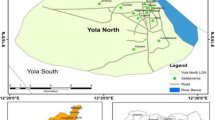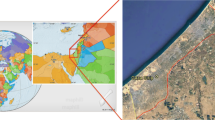Abstract
Land use/land cover in coastal regions of large cities is affected due to rapid urbanization and industrialization. Chennai, a coastal city of Tamil Nadu, India, has witnessed tremendous changes in land use/land cover over the past two decades. Post-classification correlation change detection method was used to identify the changes over the decade. To ensure image classification and precise land use land cover (LULC) mapping, the different image enhancement, atmospheric correction, information extraction techniques and unsupervised classification algorithms were carried out. The study reveals that the support vector machine(SVM) and maximum likelihood gave higher accuracies with the rate of 91.50% and 92.25% for the years 2005 and 2016, respectively. The study showed that wetness land cover area has decreased by 10.05 (0.98%) from 2005 to 2016. Conversely, as a result of the expansion of new industrial, commercial, and residential areas, the built-up area has remarkably increased by 363.99 km2 (10.13%) from 2005 to 2016. Different algorithms were used to process the thermal infrared data of Landsat satellite images to accurately estimate land surface temperature (LST). From various emissivity models, a minor shift in LST was found and the cross-validation of the results obtained indicated that the outcome of this study is reliable. A new integrated enhancement method was demonstrated to extract the impervious land surface. A positive correlation with LST to the impervious surface and a negative correlation with vegetation at the regional scale were obtained. Thus, the study demonstrated the relationship between the LULC changes over 11 years and their relationship with the LST and other environmental parameters of a large metropolitan city of India.













Similar content being viewed by others
References
Abdulaziz AM, Hurtado JJM, Al-Douri R (2009) Application of multi-temporal Landsat data to monitor land cover changes in the Eastern Nile Delta Region, Egypt. Int J Remote Sens 30:2977–2996
Aboelnour M, Engel BA (2018) Application of remote sensing techniques and geographic information systems to analyze land surface temperature in response to land use/land cover change in the Greater Cairo Region, Egypt. J Geogr Syst 10:57–88
Alhawiti RH, Mitsova D (2016) Using Landsat-8 data to explore the correlation between urban land heat island and urban land uses. International Journal of Research in Engineering and Technology 5:457–466
Ali M, Qaid, Basavarajappa (2008) Application of optimum index factor technique to Landsat-7 data for geological mapping of North East of Hajjah, Yemen. American-Eurasian Journal of Scientific Research 3(1):84–91
Basic Road Statistics of India (2016-2017) Government of India, Ministry of Road Transport & highways Transport Research, Wing, New Delhi, India available at www.morth.nic.in
Bhagyanagar R, Kawal BM, Dwarakish GS, Surathkal S (2012) Land use land cover change and urban expansion during 1983-2008 in the coastal area of Dakshina Kannada District, South India. J Appl Remote Sens 6:63576–63571
Census of India (2011) Provisional population totals, Office of Registrar General of and Census Commissioner of India, Government of India.
Chander G, Markham B (2003) Revised Landsat-5 TM radiometric calibration procedures and post calibration dynamic ranges. IEEE Transaction on Geoscience and Remote Sensing 41:2674–2677
Chander G, Markham BL, Helder DL (2009) Summary of current radiometric calibration coefficients for Landsat MSS, TM, ETM+, and EO-1 ALI sensors. Remote Sensing of Environment 113(5):893–903
Chanu CHS, Munagapati H, Tiwari VM, Kumar A, Elango L (2020) Use of GRACE time-series data for estimating groundwater storage at small scale. Journal of Earth System Science 129:1
Chavez P, Berlin G, Sowers L (1982) Statistical method for selecting Landsat MSS ratios. J Appl Photogr Eng 8:23–30
Congalton RG (1991) A review of assessing the accuracy of classifications of remotely sensed data. Remote Sens Environ 37:35–46
Esam I, Abdalla F, Erich N (2012) Land use and land cover changes of west Tahta Region, Sohag Governorate, Upper Egypt. J Geogr Inf Syst 4:483–493
Faridatul MI (2017) Spatiotemporal effects of land use and river morphological change on the microclimate of Rajshahi metropolitan area. J Geogr Inf Syst 9:466–481
Giannini MB, Belfiore OR, Parente C, Santamaria R (2015) Land surface temperature from Landsat 5 TM images: comparison of different method using airborne thermal data. Journal of Engineering Science and Technology Review 8:83–90
Gwet K (2002) Kappa statistic is not satisfactory for assessing the extent of agreement between raters. Statistical Methods for Inter-Rater Reliability Assessment 1:1–6
Huete A (1988) A soil-adjusted vegetation index (SAVI). Remote Sens Environ 25:295–309
Kimuku CW, Ngigi M (2017) Study of urban heat island trends to Aid in urban planning in Nakuru county-Kenya. J Geogr Inf Syst 9:309–325
Kuntal Ganguly, Ravi Shankar G (2014) Geo-Environment appraisal for studying urban environment and its associated biophysical parameters using Remote Sensing and GIS technique. https://www.researchgate.net/publication/269408308
Li L, Tan Y, Ying S, Yu Z, Li Z, Lan H (2014) Impact of land cover and population density on land surface temperature: case study in Wuhan, China. J Appl Remote Sens 8:1–19
Lu D, Weng Q (2009) Extraction of urban impervious surface from an IKONOS image. Int J Remote Sens 30(5):1297–1311
LULC 50K Atlas (India) (2011) Land use land cover Atlas of India (based on multi-temporal satellite date of 2005-06). Hyderabad: National Remote Sensing Centre
Mallick J, Kant Y, Bharath BD (2008) Estimation of land surface temperature over Delhi using Landsat-7 ETM+. Journal of Indian Geophysical Union 12:131–140
Pal S, Ziaul S (2016) Detection of Land Use and Land Cover Change and Land Surface Temperature in English Bazar Urban Centre. Egypt J Remote Sens Space Sci 20:125–145
Qaid AM, Basavarajappa HT (2008) Application of Optimum Index Factor Technique to Landsat – 7 Data for Geological Mapping of North East of Hajjah, Yemen. American – Eurasian Journal Scientific Research 3:84–91
Ridd MK, Liu J (1998) A comparison of four algorithms for change detection in an urban environment. Remote Sens Environ 63:95–100
United Nations Population Division (2019) World population projects: the 2001 revision, New York
USGS (United States Geological Survey) Landsat 8 product, 2016 USGS. (https://www.landsat.usgs.gov/Landsat8_Using_Product.php)
Viera AJ, Garrett JM (2005) Understanding interobserver agreement: the kappa statistic. Fam Med 37:360–363
Xu H (2006) Modification of normalized difference water index (NDWI) to enhance open water features in remotely sensed imagery. Int J Remote Sens 27(14):3025–3033
Xu H (2007) A new index for delineating built-up land features in satellite imagery. Int J Remote Sens 29(14):4269–4276
Yang X (2002) Satellite monitoring of urban spatial growth in the Atlantic Metropolitan Area. Photogramm Eng Remote Sens 68:725–734
Yuan F, Sawaya KE, Loeffelholz BC, Bauer ME (2005) Land cover classification and change analysis of the twin cities (Minnesota) metropolitan area by multitemporal Landsat remote sensing. Remote Sens Environ 98:317–328
Zanter K (2016) Landsat 8 (L8) Data users handbook. LSDS-1574 Version,2:1-106
Zha Y, Gao J, Ni S (2003) Use of normalized difference built-up index in automatically mapping urban areas from TM imagery. Int J Remote Sens 24:583–594
Funding
This study was funded by the Department of Science and Technology, New Delhi (Grant no. DST/CCP/NCC&CV/135/2017(G)).
Author information
Authors and Affiliations
Corresponding author
Additional information
Responsible Editor: Amjad Kallel
Rights and permissions
About this article
Cite this article
Chanu, C.S., Elango, L. & Shankar, G.R. A geospatial approach for assessing the relation between changing land use/land cover and environmental parameters including land surface temperature of Chennai metropolitan city, India. Arab J Geosci 14, 132 (2021). https://doi.org/10.1007/s12517-020-06409-0
Received:
Accepted:
Published:
DOI: https://doi.org/10.1007/s12517-020-06409-0




